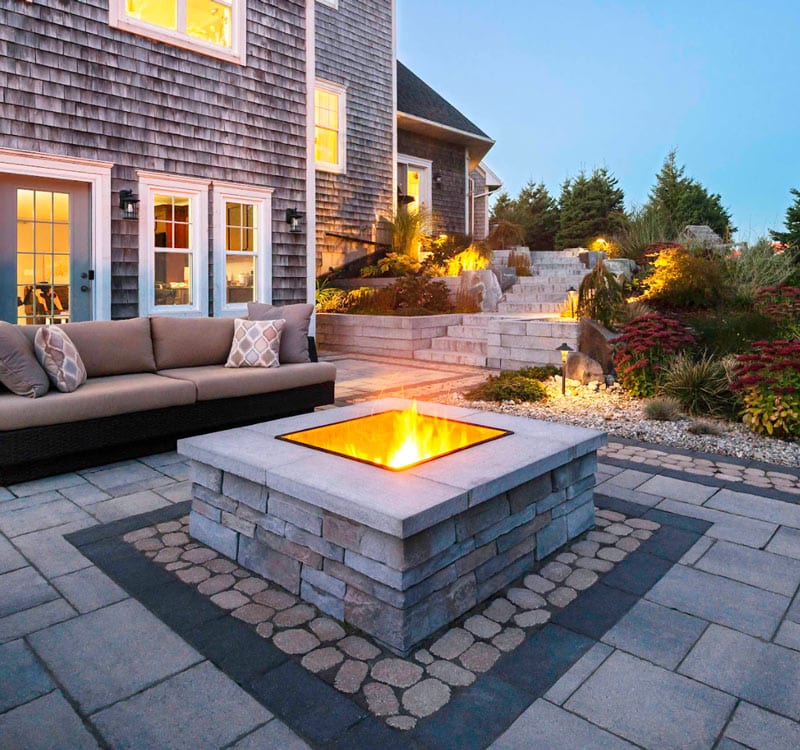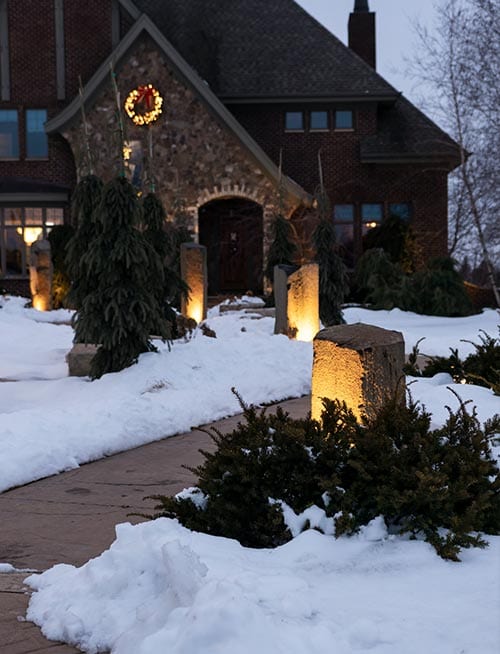
Photographers, filmmakers, and landscape designers know that achieving the right lighting effect is as much art as it is science.
Science explains why photographers will avoid midday shoots when light intensity is high.
-
- The light is harsh
- There are no shadows
- Colors are washed out
- There’s too much reflection
- There can be blind spots
The art of landscape lighting is creating interesting shadows, a sense of pause or motion, or providing visual cues that safely lead people to their destination.
The art of working with light is akin to working with musical notes and the spaces between them. Without those spaces between the notes, it’s just noise. And without darkness to create interesting lighting effects, the nighttime landscape experience is equally unacceptable.
Here are nine techniques landscape lighting professionals use to achieve outdoor living experiences that delight and surprise those who enjoy the night as much as daytime.
#1. Color Balance
This poem from the Nights In White Satin, a song by Rock & Roll Hall of Fame inductees, The Moody Blues, reveals insights into how colors can appear in a moonlit landscape.
“Cold-hearted orb that rules the night
Removes the colors from our sight
Red is gray and yellow white
But we decide which is right
And which is an illusion”
If the nighttime sky is clear and there is a full moon, you will discover that red can indeed appear to be gray, and yellows and other light hues appear white. This awareness and ample experimentation can lead to unexpected lighting outcomes.
The nighttime landscape is an opportunity for playing with the light that suits more relaxed activities appropriate for that time of day. You can turn up the light to have truer hues, but most people tend to enjoy a balanced canvas.
Even color experts are surprised at what happens when lighting blends and complementary and contrasting color combinations. The only way to get the right mix is by applying color principles and testing strategic lighting scenarios. to discover what works best.
#2. Weather Conditions
Photographers know that colors change throughout the day due to factors such as humidity and temperature gradients. The same is true for natural moonlight and artificial nighttime lighting.
Consideration should be given to increasing or decreasing natural light by managing how much moonlight illuminates a surface, often by accounting for reflection and light absorption. For example, the thin needles of evergreen trees tend to absorb light while broad, shiny deciduous leaves easily reflect it.
Large-leaved hostas, such as the fragrant H. plantaginea and H. sieboldiana ‘Elegans’ have bold textures that reflect artificial and moonlight quite nicely. This is further emphasized when the leaves are wet from dew or a recent storm.
Kentucky Coffee Tree and Swamp White Oak are two trees valued for their interesting bark texture.
Those textures can be featured by illuminating the trees with uplights that graze the surface of the trunks. It can be especially striking during the winter months when all the leaves have fallen and branching is in full view.
Downlighting branches will create shadows against a bed of snow that can be stunning.
#3. Movement and Flow
While lighting can sometimes be difficult, water is a favorite for creating movement in the nighttime landscape. Ripples in reflecting pools and ponds are softly illuminated by full moonlight. Supplemental landscape lighting can be designed to accentuate this effect.
Another type of movement is achieved with ornamental grasses such as Calamagrostis x acutiflora ‘Karl Foerster.’ This 4-5′ perennial grass thrives in our Minnesota climate.
It offers exceptional winter interest, including movement with even the most gentle breeze. Warm, low-voltage lighting will capture that movement which is further emphasized when the seed tips are frosted with frozen dew.
#4. Forms and Shapes

Repetition is a design principle that stands out in a design when the repetition is captured with lighting.
In the image above basalt columns signal the path to the home’s primary entrance. This gives the home and its front walkway perspective that anchors it to the surrounding landscape.
These effects can be employed by backlighting rows of trees or shrubs. The lighting captures the shapes of the plantings when it leaks around the edges of the branches. The effect is subtle and often dramatic.
While many trees have rounded canopies, some have distinctive shapes, such as the pyramidal form of the Lindens. The staccato pattern of the pyramidal Lindens could be softened with masses of white flowering shrubs such as Hydrangeas.
It only takes a light touch to illuminate white flowering plants, with moonlight often adding to the effect. This same effect can be achieved with masses of whitish-gray perennials, such as Artemesias and Stachys.
#5. Formal and Informal Emphasis
A formal element in a landscape design stands out when properly lighted. One, four, or eight-element formal patterns will pop with accent lighting.
An alternative is to de-emphasize these stronger elements in the design by placing more emphasis on the frame, such as a perimeter row of shrubs. It all depends on how you wish to experience the space.
If you want to relax in your outdoor living space during the evening hours, it makes sense to illuminate the perimeter so that you can enjoy your privacy. In contrast, elegantly lighting elements that are central to the primary spaces provide subtle security lighting.
#6. Linear and Circular Lines
Lines are among the most powerful landscape design elements because whether they are curved or linear, our eye naturally follows them. How lighting is used to emphasize this quality can be tricky because it is often overused.
You are probably seen Christmas Light displays that illuminate every horizontal, vertical, and diagonal roofline on the home. A more elegant approach is lighting key features of the home’s entrance. Then gives this focal point context by choosing related features in the surrounding landscape to light.
This lighting can be especially dramatic with larger properties. Balanced lighting that anchors elements to the property during the evening hours creates interesting views around every corner.
The usefulness of line as a design element was not unnoticed by famed landscape architect Jens Jenson. He was known to say that you make primary spaces stronger by controlling the edges.
For this discussion, that means considering how to do that with lighting.
#7. Space and Shadows
To make the most of natural moonlight, it’s important to design open spaces that will reveal interesting shadows. After deciduous plantings have dropped their leaves, our Minnesota autumns and winters are ripe with opportunities for creating fascinating shadows.
If you study the shadows of plantings and hardscape features in the nighttime landscape you’ll discover interesting shadows are to be found everywhere. The trick is finding ways to put this principle to work.
If your bluestone terrace is where you enjoy relaxing in the evenings, why not consider strategically locating one or a grouping of Kentucky Coffee Trees and lighting to shadow portions of it?
We notice colorful plantings filling spaces during the daytime, such as the foreground of a favorite view. Shadows and shapes fill open spaces too, either with plants or their shadows from landscape lighting.
#8. Transitions and Intersections

Most accidents happen at transitions, the intersections of spaces in landscapes. Landscape architects often refer to these as what they are, trip points.
Lighting these transition areas is a smart design practice because it relaxes people’s minds, removing doubt about what lies ahead.
Using landscape lighting to guide people through the landscape transforms it into a pleasing experience. Clear transitions that reflect thoughtful planning and design are the marks of professionals.
While it is tempting to simply light transitions in the landscape, lighting nearby specimen plantings or focal features that mark the transition is a more skillful approach.
#9. Safety Planning
Safety considerations are paramount for any landscape, especially when features such as pools, ponds, fire pits, and outdoor grills are involved. There should be lighting that alerts people to what’s ahead so that they do not turn a corner and discover the unexpected.
When used incorrectly, lighting can create ‘hot spots’ that can become safety hazards. This occurs when directional lighting is at or about eye level. Sometimes the best way to solve the problem is evaluating the effects of the lighting from all angles.
If this does not work it will be necessary to try different lighting fixtures and vary the intensity.
We Can Make It Work For You
Professional landscape lighting is an opportunity to extend the functional use of your property, elevate its style, and make it safe during nighttime and early morning hours.
It only takes an internet search to discover that landscape lighting system choices are seemingly endless. We hope this article provides some clarity on lighting techniques, but there’s so much more to it.
We’ll guide you through our proven process for making it work. Please contact us for a casual, no-obligation analysis.
